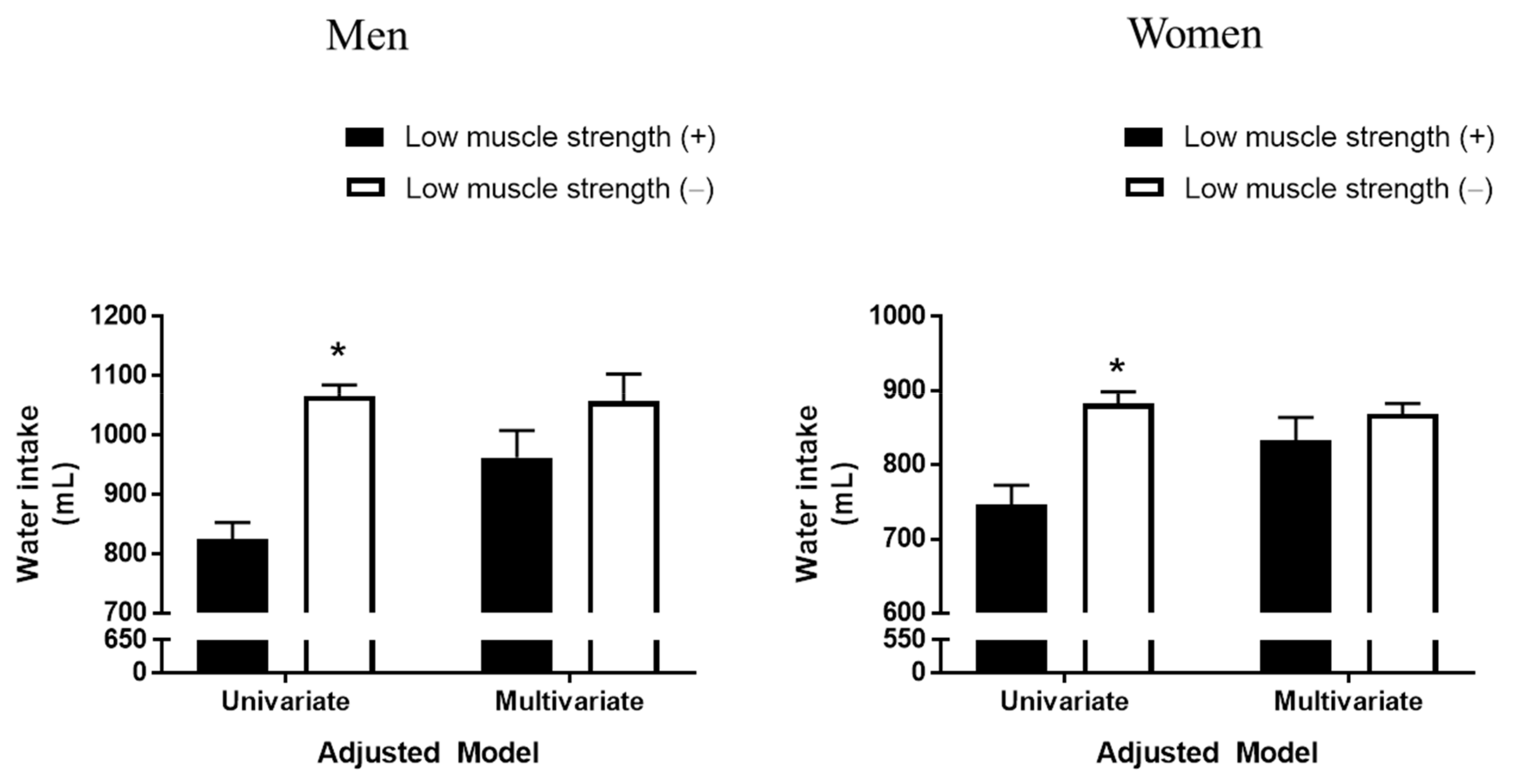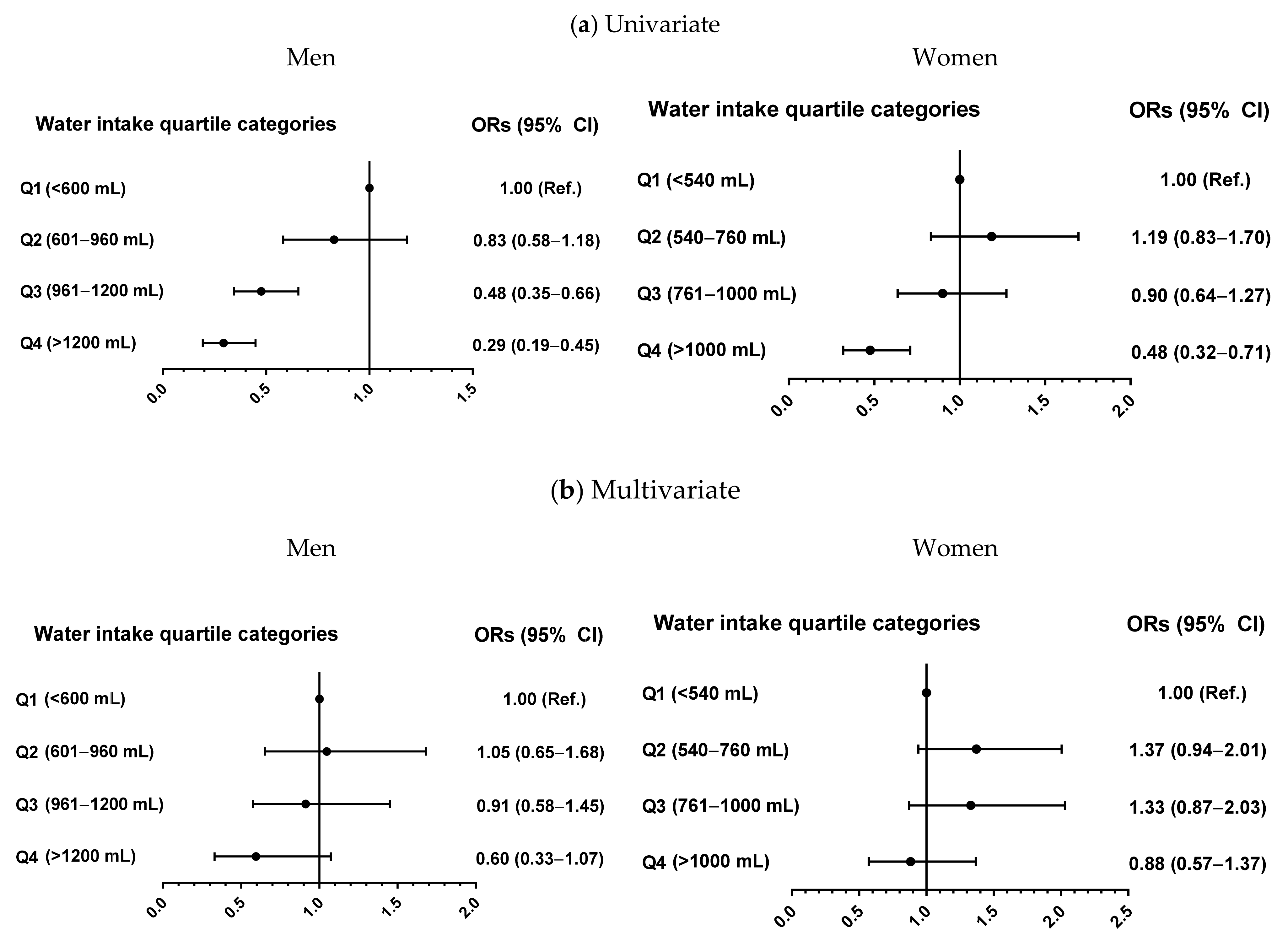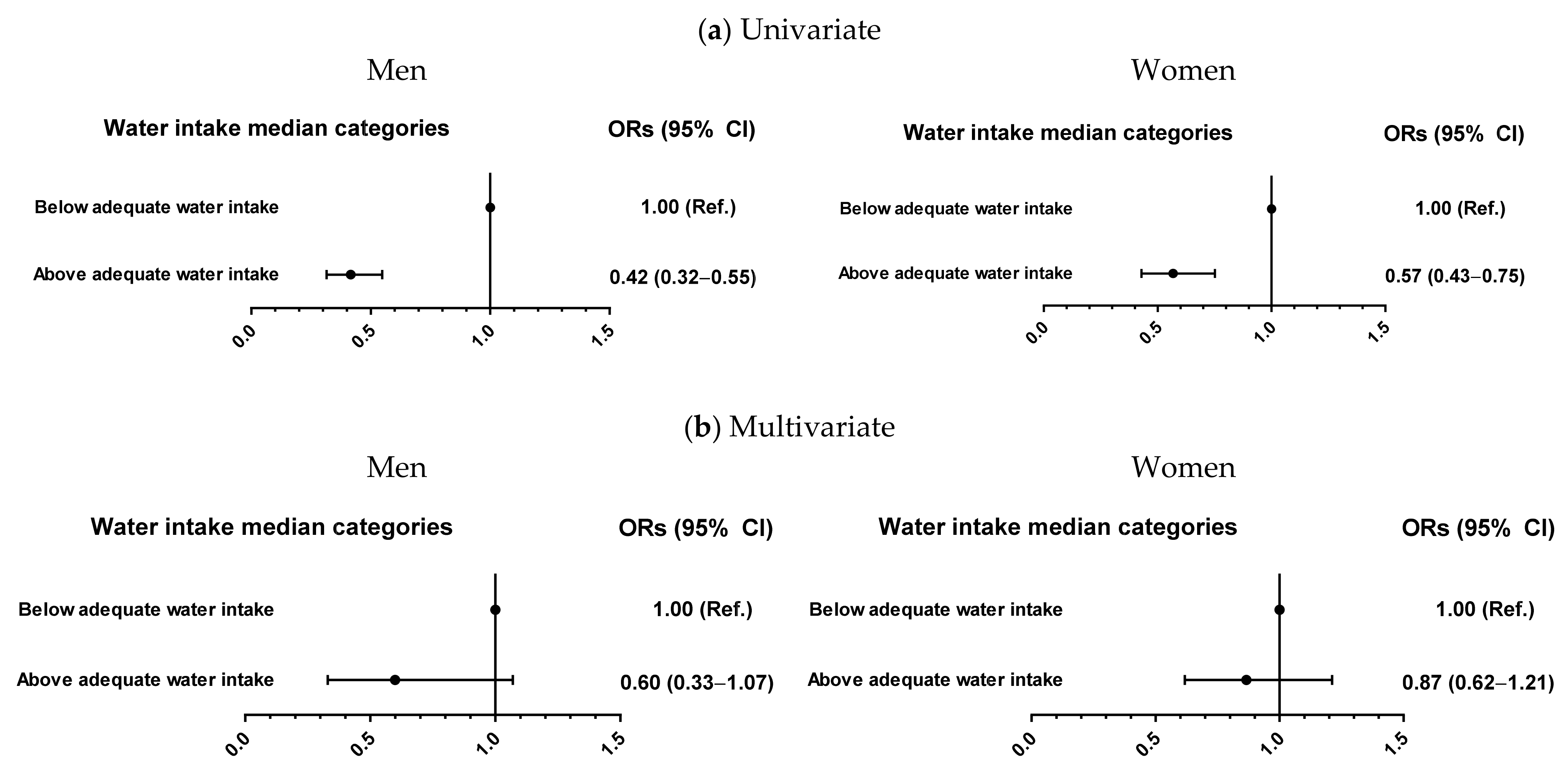Association of Water Intake with Hand Grip Strength in Community-Dwelling Older Adults
Abstract
1. Introduction
2. Materials and Methods
2.1. Study Participants
2.2. Measurements of HGS
2.3. Assessment of Water Intake and Definition of Adequate Water Intake
2.4. Measurements of Dietary, Laboratory and Clinical Parameters
2.5. Statistical Analysis
3. Results
3.1. Clinical Characteristics of the Study Participants
3.2. Association between Water Intake and Low Muscle Strength
3.3. Correlation of HGS with Clinical Parameters
3.4. Risk of Low Muscle Strength According to Water Intake Amount
3.5. Effects of Adequate Water Intake on HGS and Risk of Low Muscle Strength
4. Discussion
Author Contributions
Funding
Institutional Review Board Statement
Informed Consent Statement
Data Availability Statement
Conflicts of Interest
References
- Beaudart, C.; Rizzoli, R.; Bruyère, O.; Reginster, J.Y.; Biver, E. Sarcopenia: Burden and challenges for public health. Arch. Public Health Arch. Belg. Sante Publique 2014, 72, 45. [Google Scholar] [CrossRef] [PubMed]
- Dao, T.; Green, A.E.; Kim, Y.A.; Bae, S.J.; Ha, K.T.; Gariani, K.; Lee, M.R.; Menzies, K.J.; Ryu, D. Sarcopenia and muscle aging: A brief overview. Endocrinol. Metab. Seoul 2020, 35, 716–732. [Google Scholar] [CrossRef] [PubMed]
- Mitchell, W.K.; Williams, J.; Atherton, P.; Larvin, M.; Lund, J.; Narici, M. Sarcopenia, dynapenia, and the impact of advancing age on human skeletal muscle size and strength; a quantitative review. Front. Physiol. 2012, 3, 260. [Google Scholar] [CrossRef]
- Goodpaster, B.H.; Park, S.W.; Harris, T.B.; Kritchevsky, S.B.; Nevitt, M.; Schwartz, A.V.; Simonsick, E.M.; Tylavsky, F.A.; Visser, M.; Newman, A.B. The loss of skeletal muscle strength, mass, and quality in older adults: The health, aging and body composition study. J. Gerontol. Ser. A Biol. Sci. Med Sci. 2006, 61, 1059–1064. [Google Scholar] [CrossRef] [PubMed]
- Bohannon, R.W. Muscle strength: Clinical and prognostic value of hand-grip dynamometry. Curr. Opin. Clin. Nutr. Metab. Care 2015, 18, 465–470. [Google Scholar] [CrossRef] [PubMed]
- Granic, A.; Jagger, C.; Davies, K.; Adamson, A.; Kirkwood, T.; Hill, T.R.; Siervo, M.; Mathers, J.C.; Sayer, A.A. Effect of dietary patterns on muscle strength and physical performance in the very old: Findings from the Newcastle 85+ study. PLoS ONE 2016, 11, e0149699. [Google Scholar] [CrossRef] [PubMed]
- Cruz-Jentoft, A.J.; Bahat, G.; Bauer, J.; Boirie, Y.; Bruyère, O.; Cederholm, T.; Cooper, C.; Landi, F.; Rolland, Y.; Sayer, A.A.; et al. Sarcopenia: Revised European consensus on definition and diagnosis. Age Ageing 2019, 48, 601. [Google Scholar] [CrossRef] [PubMed]
- Lorenzo, I.; Serra-Prat, M.; Yébenes, J.C. The role of water homeostasis in muscle function and frailty: A review. Nutrients 2019, 11, 1857. [Google Scholar] [CrossRef]
- Johnson, E.C.; Adams, W.M. Water intake, body water regulation and health. Nutrients 2020, 12, 702. [Google Scholar] [CrossRef]
- Hackney, K.J.; Cook, S.B.; Fairchild, T.J.; Ploutz-Snyder, L.L. Skeletal muscle volume following dehydration induced by exercise in heat. Extrem. Physiol. Med. 2012, 1, 3. [Google Scholar] [CrossRef]
- Nose, H.; Morimoto, T.; Ogura, K. Distribution of water losses among fluid compartments of tissues under thermal dehydration in the rat. Jpn. J. Physiol. 1983, 33, 1019–1029. [Google Scholar] [CrossRef]
- Harris, P.R.; Keen, D.A.; Constantopoulos, E.; Weninger, S.N.; Hines, E.; Koppinger, M.P.; Khalpey, Z.I.; Konhilas, J.P. Fluid type influences acute hydration and muscle performance recovery in human subjects. J. Int. Soc. Sports Nutr. 2019, 16, 15. [Google Scholar] [CrossRef]
- Beasley, K.N.; Lee, E.C.; McDermott, B.P.; Yamamoto, L.M.; Emmanuel, H.; Casa, D.J.; Armstrong, L.E.; Kraemer, W.J.; Maresh, C.M. The effect of oral vs. intravenous rehydration on circulating myoglobin and creatine kinase. J. Strength Cond. Res. 2010, 24, 60–67. [Google Scholar] [CrossRef]
- Ayotte, D., Jr.; Corcoran, M.P. Individualized hydration plans improve performance outcomes for collegiate athletes engaging in in-season training. J. Int. Soc. Sports Nutr. 2018, 15, 27. [Google Scholar] [CrossRef]
- Kim, J.; Yang, Y.J. Plain water intake of Korean adults according to life style, anthropometric and dietary characteristic: The Korea national health and nutrition examination surveys 2008–2010. Nutr. Res. Pract. 2014, 8, 580–588. [Google Scholar] [CrossRef]
- Sontrop, J.M.; Dixon, S.N.; Garg, A.X.; Buendia-Jimenez, I.; Dohein, O.; Huang, S.H.; Clark, W.F. Association between water intake, chronic kidney disease, and cardiovascular disease: A cross-sectional analysis of NHANES data. Am. J. Nephrol. 2013, 37, 434–442. [Google Scholar] [CrossRef]
- Yoo, J.I.; Choi, H.; Song, S.Y.; Park, K.S.; Lee, D.H.; Ha, Y.C. Relationship between water intake and skeletal muscle mass in elderly Koreans: A nationwide population-based study. Nutrition 2018, 53, 38–42. [Google Scholar] [CrossRef]
- Kweon, S.; Kim, Y.; Jang, M.J.; Kim, Y.; Kim, K.; Choi, S.; Chun, C.; Khang, Y.H.; Oh, K. Data resource profile: The Korea national health and nutrition examination survey (KNHANES). Int. J. Epidemiol. 2014, 43, 69–77. [Google Scholar] [CrossRef]
- Cadenas-Sanchez, C.; Sanchez-Delgado, G.; Martinez-Tellez, B.; Mora-Gonzalez, J.; Löf, M.; España-Romero, V.; Ruiz, J.R.; Ortega, F.B. Reliability and validity of different models of TKK hand dynamometers. Am. J. Occup. Ther. Off. Publ. Am. Occup. Ther. Assoc. 2016, 70, 7004300010. [Google Scholar] [CrossRef]
- Yoo, J.I.; Choi, H.; Ha, Y.C. Mean hand grip strength and cut-off value for sarcopenia in Korean adults using KNHANES VI. J. Korean Med. Sci. 2017, 32, 868–872. [Google Scholar] [CrossRef]
- The Korean Nutrition Society. Dietary Reference Intakes for Koreans; Ministry of Health and Welfare: Sejong, Korea, 2015.
- Rural Development Administration. Food Composition Table, 7th ed.; National Rural Resources Development Institute: Suwon, Korea, 2006.
- Klahr, S. The modification of diet in renal disease study. N. Engl. J. Med. 1989, 320, 864–866. [Google Scholar] [CrossRef] [PubMed]
- Tomlinson, D.J.; Erskine, R.M.; Morse, C.I.; Winwood, K.; Onambélé-Pearson, G. The impact of obesity on skeletal muscle strength and structure through adolescence to old age. Biogerontology 2016, 17, 467–483. [Google Scholar] [CrossRef]
- McGregor, R.A.; Cameron-Smith, D.; Poppitt, S.D. It is not just muscle mass: A review of muscle quality, composition and metabolism during ageing as determinants of muscle function and mobility in later life. Longev. Healthspan 2014, 3, 9. [Google Scholar] [CrossRef] [PubMed]
- Walston, J.D. Sarcopenia in older adults. Curr. Opin. Rheumatol. 2012, 24, 623–627. [Google Scholar] [CrossRef] [PubMed]
- Newman, A.B.; Kupelian, V.; Visser, M.; Simonsick, E.M.; Goodpaster, B.H.; Kritchevsky, S.B.; Tylavsky, F.A.; Rubin, S.M.; Harris, T.B. Strength, but not muscle mass, is associated with mortality in the health, aging and body composition study cohort. J. Gerontol. Ser. A Biol. Sci. Med. Sci. 2006, 61, 72–77. [Google Scholar] [CrossRef]
- Cawthon, P.M.; Fox, K.M.; Gandra, S.R.; Delmonico, M.J.; Chiou, C.F.; Anthony, M.S.; Sewall, A.; Goodpaster, B.; Satterfield, S.; Cummings, S.R.; et al. Do muscle mass, muscle density, strength, and physical function similarly influence risk of hospitalization in older adults? J. Am. Geriatr. Soc. 2009, 57, 1411–1419. [Google Scholar] [CrossRef]
- Stookey, J.D.; Kavouras, S.A. Water researchers do not have a strategic plan for gathering evidence to inform water intake recommendations to prevent chronic disease. Nutrients 2020, 12, 3359. [Google Scholar] [CrossRef] [PubMed]
- Frederiksen, H.; Hjelmborg, J.; Mortensen, J.; McGue, M.; Vaupel, J.W.; Christensen, K. Age trajectories of grip strength: Cross-sectional and longitudinal data among 8342 Danes aged 46 to 102. Ann. Epidemiol. 2006, 16, 554–562. [Google Scholar] [CrossRef]
- Pasdar, Y.; Darbandi, M.; Mirtaher, E.; Rezaeian, S.; Najafi, F.; Hamzeh, B. Associations between muscle strength with different measures of obesity and lipid profiles in men and women: Results from RaNCD cohort study. Clin. Nutr. Res. 2019, 8, 148–158. [Google Scholar] [CrossRef] [PubMed]
- Barbalho, M.; Souza, D.; Coswig, V.; Abrahin, O.; Paoli, A.; Gentil, P. The effects of resistance exercise selection on muscle size and strength in trained women. Int. J. Sports Med. 2020. [Google Scholar] [CrossRef] [PubMed]
- Chen, L.K.; Liu, L.K.; Woo, J.; Assantachai, P.; Auyeung, T.W.; Bahyah, K.S.; Chou, M.Y.; Chen, L.Y.; Hsu, P.S.; Krairit, O.; et al. Sarcopenia in Asia: Consensus report of the Asian working group for sarcopenia. J. Am. Med Dir. Assoc. 2014, 15, 95–101. [Google Scholar] [CrossRef] [PubMed]
- Cruz-Jentoft, A.J.; Baeyens, J.P.; Bauer, J.M.; Boirie, Y.; Cederholm, T.; Landi, F.; Martin, F.C.; Michel, J.P.; Rolland, Y.; Schneider, S.M.; et al. Sarcopenia: European consensus on definition and diagnosis: Report of the European working group on sarcopenia in older people. Age Ageing 2010, 39, 412–423. [Google Scholar] [CrossRef]




| Variables | Men (n = 2090) | Women (n = 2353) | ||||
|---|---|---|---|---|---|---|
| Low Muscle Strength | Low Muscle Strength | |||||
| (+; n = 379) | (−; n = 1711) | p Value | (+; n = 343) | (−; n = 2010) | p Value | |
| Age, y | 73.14 ± 0.36 | 62.94 ± 0.20 | <0.001 | 71.85 ± 0.42 | 62.80 ± 0.20 | <0.001 |
| Height, cm | 162.68 ± 0.29 | 167.51 ± 0.14 | <0.001 | 149.50 ± 0.33 | 154.55 ± 0.13 | <0.001 |
| Weight, kg | 60.15 ± 0.47 | 68.03 ± 0.23 | <0.001 | 53.88 ± 0.46 | 57.91 ± 0.19 | <0.001 |
| Body mass index, kg/m2 | 22.71 ± 0.16 | 24.21 ± 0.07 | <0.001 | 24.06 ± 0.18 | 24.24 ± 0.07 | 0.352 |
| Educational level, % | <0.001 | <0.001 | ||||
| Less than high school | 70.3 | 44.5 | 87.3 | 61.0 | ||
| High school or advanced | 29.7 | 55.5 | 12.7 | 39.0 | ||
| Household income quartile, % | <0.001 | <0.001 | ||||
| 1 (lowest) | 51.3 | 20.3 | 55.8 | 27.3 | ||
| 2 | 25.5 | 28.2 | 22.5 | 26.7 | ||
| 3 | 12.8 | 24.6 | 13.7 | 21.9 | ||
| 4 | 10.4 | 26.9 | 8.0 | 24.1 | ||
| Smoking status, % | <0.001 | 0.001 | ||||
| Never | 28.7 | 21.7 | 92.2 | 94.6 | ||
| Former | 53.8 | 49.4 | 5.0 | 2.8 | ||
| Current | 17.5 | 28.9 | 2.9 | 2.6 | ||
| Heavy alcohol drinking, % | 0.771 | <0.001 | ||||
| Yes | 16.9 | 16.1 | 6.4 | 3.2 | ||
| No | 83.1 | 83.9 | 93.6 | 96.8 | ||
| Resistance exercise, % | <0.001 | <0.001 | ||||
| No | 80.8 | 67.6 | 95.9 | 84.1 | ||
| Intermittent | 5.7 | 13.5 | 2.6 | 8.5 | ||
| Regular | 13.6 | 18.9 | 1.5 | 7.4 | ||
| Total energy, kcal/d | 1811.65 ± 37.92 | 2264.79 ± 23.31 | <0.001 | 1447.22 ± 34.88 | 1692.41 ± 15.64 | <0.001 |
| Total proteins, g/d | 55.79 ± 1.48 | 77.43 ± 1.55 | <0.001 | 45.32 ± 1.43 | 56.21 ± 0.66 | <0.001 |
| Unadjusted for Covariates | Adjusted for Covariates | |||||
|---|---|---|---|---|---|---|
| Independent Variables | ß | SE | p Value | ß | SE | p Value |
| Men | ||||||
| Age | −0.453 | 0.016 | <0.001 | −0.398 | 0.017 | <0.001 |
| Body mass index | 0.591 | 0.063 | <0.001 | 0.363 | 0.059 | <0.001 |
| Smoking status | −0.002 | 0.001 | 0.112 | −0.444 | 0.190 | 0.020 |
| Heavy alcohol drinking | −0.002 | 0.001 | 0.113 | 0.084 | 0.178 | 0.638 |
| Resistance exercise | 0.636 | 0.249 | 0.011 | 0.642 | 0.234 | 0.006 |
| Total energy intake | 0.002 | 0.001 | <0.001 | 0.001 | 0.000 | 0.016 |
| Protein intake | 0.022 | 0.012 | 0.054 | 0.000 | 0.005 | 0.964 |
| Water intake | 0.002 | 0.000 | <0.001 | 0.000 | 0.000 | 0.379 |
| Women | ||||||
| Age | −0.266 | 0.012 | <0.001 | −0.257 | 0.012 | <0.001 |
| Body mass index | 0.080 | 0.040 | 0.048 | 0.130 | 0.037 | <0.001 |
| Smoking status | −0.465 | 0.138 | 0.001 | −0.248 | 0.151 | 0.102 |
| Heavy alcohol intake | −0.322 | 0.152 | 0.035 | 0.056 | 0.168 | 0.741 |
| Resistance exercise | 1.076 | 0.172 | <0.001 | 0.539 | 0.165 | 0.001 |
| Total energy intake | 0.001 | 0.000 | <0.001 | 0.000 | 0.000 | 0.702 |
| Protein intake | 0.024 | 0.006 | <0.001 | 0.001 | 0.009 | 0.944 |
| Water intake | 0.001 | 0.000 | <0.001 | 0.000 | 0.000 | 0.233 |
Publisher’s Note: MDPI stays neutral with regard to jurisdictional claims in published maps and institutional affiliations. |
© 2021 by the authors. Licensee MDPI, Basel, Switzerland. This article is an open access article distributed under the terms and conditions of the Creative Commons Attribution (CC BY) license (https://creativecommons.org/licenses/by/4.0/).
Share and Cite
Kim, H.; Beom, S.H.; Kim, T.H.; Kim, B.-J. Association of Water Intake with Hand Grip Strength in Community-Dwelling Older Adults. Nutrients 2021, 13, 1756. https://doi.org/10.3390/nu13061756
Kim H, Beom SH, Kim TH, Kim B-J. Association of Water Intake with Hand Grip Strength in Community-Dwelling Older Adults. Nutrients. 2021; 13(6):1756. https://doi.org/10.3390/nu13061756
Chicago/Turabian StyleKim, Hyeonmok, Sun Hee Beom, Tae Ho Kim, and Beom-Jun Kim. 2021. "Association of Water Intake with Hand Grip Strength in Community-Dwelling Older Adults" Nutrients 13, no. 6: 1756. https://doi.org/10.3390/nu13061756
APA StyleKim, H., Beom, S. H., Kim, T. H., & Kim, B.-J. (2021). Association of Water Intake with Hand Grip Strength in Community-Dwelling Older Adults. Nutrients, 13(6), 1756. https://doi.org/10.3390/nu13061756






